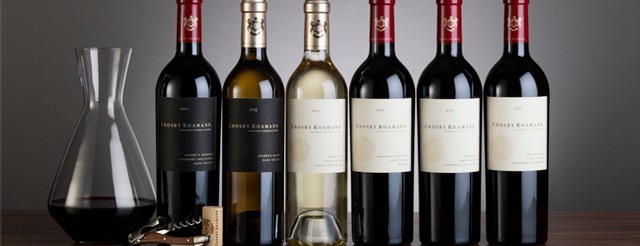Mostly Recipes, Sometimes News, Occasionally a Letter or Postcard.
New Releases & Member Shipments
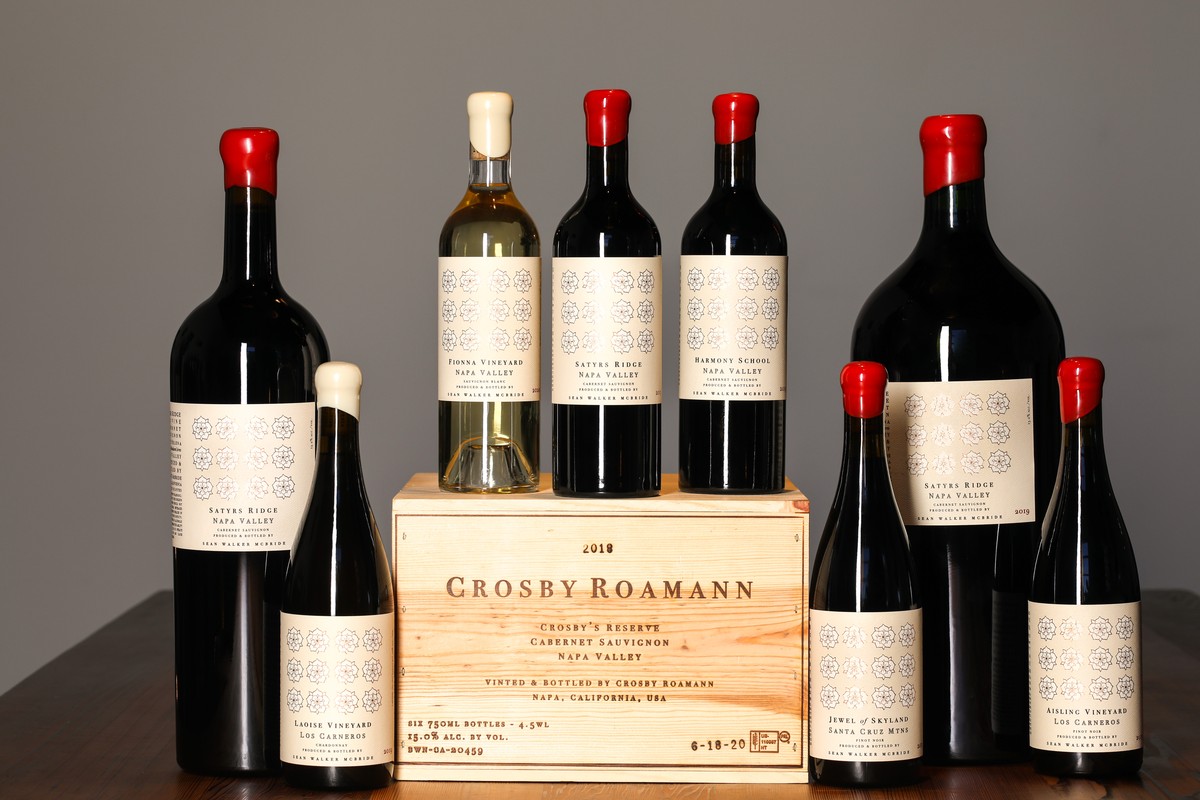
We are thrilled to release two new single vineyard wines from Napa Valley -- our 2020 Satyrs Ridge Old Vine Cabernet Sauvignon and our 2019 Harmony School Cabernet Sauvignon -- plus a new Chardonnay from the Santa Cruz Mountains. Members will also receive a library selection of our 2010 Mt. Veeder Cabernet Sauvignon from magnum.
Satyrs Ridge is a 4-acre block of Cabernet Sauvignon in Saint Helena, planted in 1970. Extremely low-yielding, we receive 1.25 tons per acre on average. We harvested the fruit at the cusp of ripeness, to preserve the integrity of the acidity and sumptuousness of the fruit. Fermented in open top stainless steel for seventeen days, then aged in one-quarter new French oak barrels for twenty-two months. Tasting notes: Dusky raspberry and briar, saddle leather, blood orange, with a touch of French oak evident but very subdued.
Harmony School is a one-acre block in Coombsville of Clone 6 Cabernet Sauvignon -- "the winemaker's clone" -- fermented on native yeasts in stainless steel for eighteen days. After a natural malolactic fermentation in barrel, we aged the wine in one-third new French oak barrels for 22 months, and bottled the wine by hand at the winery, unfined and unfiltered. On the palate: aromas of sweet raspberry and cassis emerge, with integrated vanilla and spice, cocoa and coffee on the palate.
Maeve Vineyard Chardonnay is from a very small vineyard just outside the town of Los Gatos in the Santa Cruz Mountains, on a steep bowl-shaped hillside facing southeast. Maeve is an Irish girl’s name meaning “the intoxicating one" -- but don't be fooled -- This very lightly-oaked Chardonnay is more Chablis-style than Napa, with semi-tart notes of fig, licorice, and lemon zest, and it pairs delightfully with pastas, salads, and seafood.
Member Shipments will begin to ship Fedex the last two weeks of September and will continue into October, weather depending. One Magnum from our library of 2010 Cabernet Sauvignon Mount Veeder AVA is included in the membership.
We are incredibly grateful and humbled to report a flurry of news and reviews over the past summer months! First, a review from Alder Yarrow's Vinography. Later, notes and reviews from Brian Freedman at Food & Wine Magazine, Joe Czerwinski - managing editor at The Wine Advocate, Karen MacNeil at WineSpeed, Mike Desimone and Jeff Jensen at Robb Report, and Tom Hyland at Forbes Magazine. You can find the full list at our new page dedicated to supporting Trade & Press here.
It's the perfect time of year for fresh pasta recipes with ingredients straight from the garden, and this only-very-lightly-creamy Farfalle pairs deliciously with our Maeve Vineyard Chardonnay from the Santa Cruz Mountains. Find our "Cooking with Crosby Roamann" blog online here for new recipes from our kitchen.
Maeve Vineyard is planted on a steep bowl-shaped hillside outside Los Gatos facing south and east. We whole-cluster press the juice to stainless steel for primary fermentation, and age the wine in all neutral oak and some stainless steel. A light pad filtration and cold stabilization is performed prior to bottling, by hand, at the winery. Tasting notes: Maeve Vineyard displays zesty notes of fig, licorice, and lemon zest, with apple cider and a touch of pineapple on the finish. Delightful now, the wine will gain complexity over the next year and reach its apogee from 2024 - 2027.
Forbes Magazine: The Unique Tale of Crosby Roamann Wines from California
In case you missed it, Tom Hyland for Forbes wrote a lovely piece on Crosby Roamann wines which you can find here: https://www.forbes.com/sites/tomhyland/2023/08/15/the-unique-tale-of-crosby-roamann-wines-from-california/?sh=3797ab8e2807
We are truly honored and grateful for the attention!
Cooking with Crosby Roamann: Duck a la Sean -- Seared Duck Breast with Cherries
There is something about seared duck that always seems so … decadent. But what I love about duck is how simple and easy it can be, whether we simply take a couple duck confit and crisp them gently in the broiler with some boiled potatoes and a green salad for Sunday brunch, or sear up some duck breasts in a sauté pan for a somewhat more formal dinner. This recipe falls into the latter category. It has all the hallmarks of fine French cooking, but while it is exceptionally decadent and serious, it also incredibly simple. Only a couple ingredients are needed, and the majority of the prep time is spent halving and pitting cherries, half of which get eaten by whoever is chopping or talking with me in the kitchen (you know who you are!).
This is also a terribly romantic meal, and sure to impress, with a minimum of tedium. Enjoy!
Ingredients (Serves four)
- 4 Duck breasts, about 1 pound each
- Kosher salt
- Olive oil for searing the duck breasts.
For the spice rub:
- 1 heaping teaspoon plus of freshly ground pepper (black or rainbow, I prefer rainbow)
- 1 ½ teaspoons ground allspice
- 6 crushed cloves
- ½ heaping teaspoon fennel seeds
- 1 teaspoon ground ginger
For the Cherry Sauce:
- ½ cup turbinado sugar
- ½ cup red wine vinegar
- 1 cup good red wine
- 1 cup chicken broth
- Pinch of Cayenne
- Kosher salt
- 4 tablespoons butter
- 1 pound ripe red cherries, halved and pitted by hand
- 2 tablespoons granulated sugar, like baker’s sugar
- 1 tablespoon Kirsch
Preparation
Trim excess fat from the folds of the duck skin and discard. Score the skin of the duck breasts with three 1” strips at a diagonal set 1” apart, careful not to pierce the tender meat beneath the fat. Season the duck breasts generously with Kosher salt, then evenly sprinkly the Spice Rub mixture to each top and bottom of each duck breast. Use your fingers to work the spice rub into the meat. Wrap the duck breasts in plastic and set them in the refrigerator for the balance of the day (it’s best to do this in the morning of the day you plan to cook them) -- The spice rub will infuse the duck breasts with a wonderfully gingery and tangy flavor.
Prep the sauce: Melt the turbinado sugar in red wine vinegar over medium heat, stirring continually, about 4 minutes. Add the red wine, and bring it to a boil. When the wine begins to boil, reduce the heat to medium and gently cook off the alcohol – you’ll be able to smell it when the alcohol is gone – then add the chicken broth and return the sauce to a boil. Add the ginger, pepper, and a light touch of salt, reduce the heat, and stir over a simmer for five minutes or so more. This is the sauce base, and can be set aside until you are ready to cook the cherries.
Now it’s time to prep (and snack on!) those delicious cherries. This is a good time to open a bottle of Pinot Noir and discuss the day’s events while you prep – you can find one here from Crosby Roamann – and remove the duck breasts from the fridge, unwrap them, and set them aside. For the sauce, we like to use cherries from our two cherry trees – one is a golden yellow with red highlights, and the other is a deep red – but the dish is really better with sweet red cherries from the market. Halve the cherries and pit them with a sharp paring knife, then set aside.
Melt the butter in a wide saucepan, add the sugar, and let the sugar dissolve, then add the cherries and bring this all together over high heat, stirring every minute or so. The cherries will start to break down and release their juice. When they do so, carefully add the shot of Kirsch, boil it all for one more minute, stir the sauce to bring it all together, and remove from the heat. Keep the sauce warm on the stovetop while you fire the duck breasts. (If the cherries are still too tough, you can add them back for another couple minutes on the stovetop when the duck is resting.)
Now it’s time to sear the duck and assemble your feast. In a large sauté pan with a tablespoon of olive oil over medium high heat, sear the duck breasts skin side down for about 7 minutes (you may have to work in batches, depending on the size of the duck breasts and the size of the sauté pan). Flip the breasts and continue to sear another 5 minutes. The duck should have a deeply golden-brown hue. You will know the duck is just ready when the meat shows signs of juicing into the pan. Remove from the heat and let the duck rest for 5 minutes. Then slice the duck breasts on a diagonal, cover with the warm cherry sauce, and serve.
Bon appetit!
Serving recommendation: Allard Potatoes or Fancy White Mashed Potatoes, Seared Tarragony String Beans.
Wine Pairing: Napa Valley Merlot or Sonoma Coast Pinot Noir.
Inspired by: David Tanis for The New York Times, “Dining & Wine: Recipes – Duck With Cherries and Red Wine Vinegar” downloaded June 11, 2014 at 3:40pm.
Cooking with Crosby Roamann: Penne al Tonno
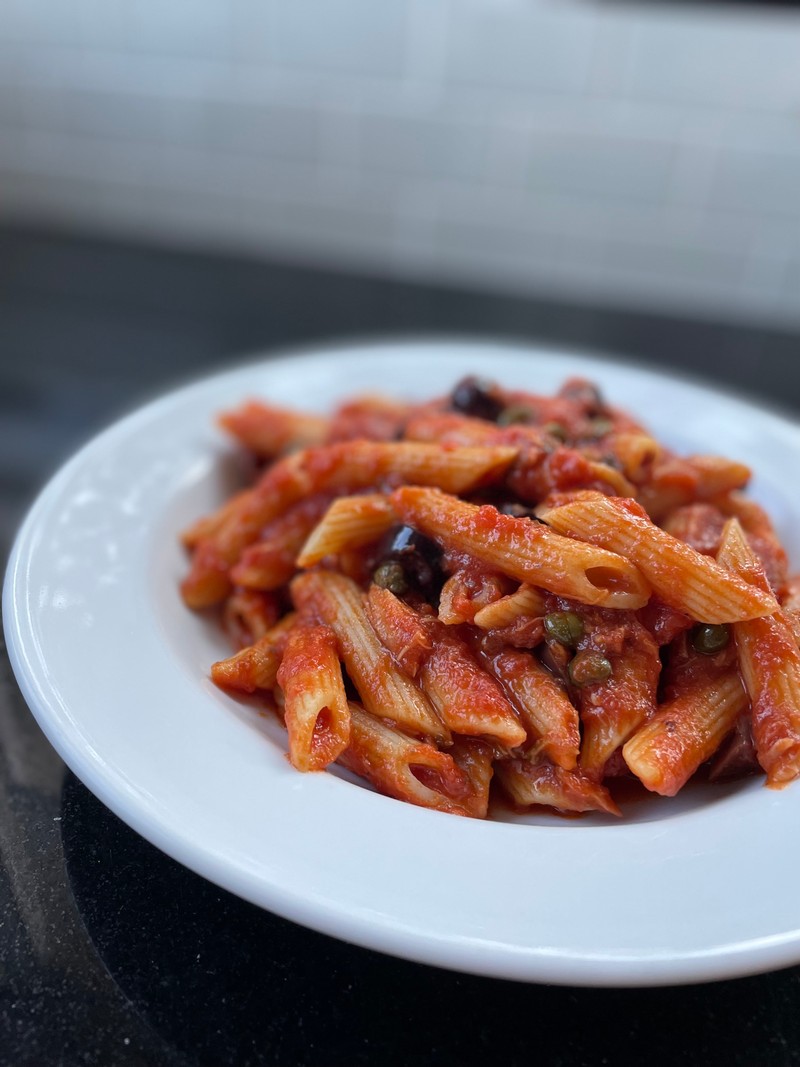
Penne al Tonno -- Penne with Tuna in Red Sauce -- is the simplest and most delicious summer pasta recipe you need to have in your weekday arsenal.
Ingredients
- 1 pound dry penne
- 1/3 cup olive oil
- 1 jar of capers (2 oz) drained
- 1 jar of Tonnino yellow fin tuna in olive oil (blue label)
- 4oz pitted black or brown olives (like from the deli counter at Whole Foods) sliced in thirds
- 1 jar of premade sauce and 1 box strained tomatoes (or just use two boxes of premade pasta sauce)
- 2 teaspoons Garlic powder or granulated garlic
- 1 teaspoon Crushed red pepper flakes
- 2 teaspoons Kosher Salt
- 6 twists of freshly cracked black (or rainbow pepper)
Preparation
- Bring a pot of salted water to a boil, add the penne, and cook for 12 minutes, making sure to stir the pasta in the beginning of the boil so it doesnt stick to the bottom of the pot.
- In a large saucepan over medium high heat, add your olive oil, and when it begins to shimmer, add the capers, letting them fry for a minute.
- Add the tuna in its olive oil, and let it fry for a couple minutes. Stir.
- Add the olives, then let them fry for a couple minutes. Stir.
- Add the pasta sauce, and the box of strained tomatoes. Bring to a gentle simmer, and stir, uncovered.
- Season with garlic powder, salt, pepper, and crushed red peppers.
- The penne should be done by now, so drain it, and return the pasta to the same pot. Pour all the hot sauce over the penne and stir to incorporate.
- Enjoy -- and hey -- grab a glass of Chardonnay !!
Cooking with Crosby Roamann: Farfalle with Creamy Smoked Salmon, Fresh Peas, and Dill
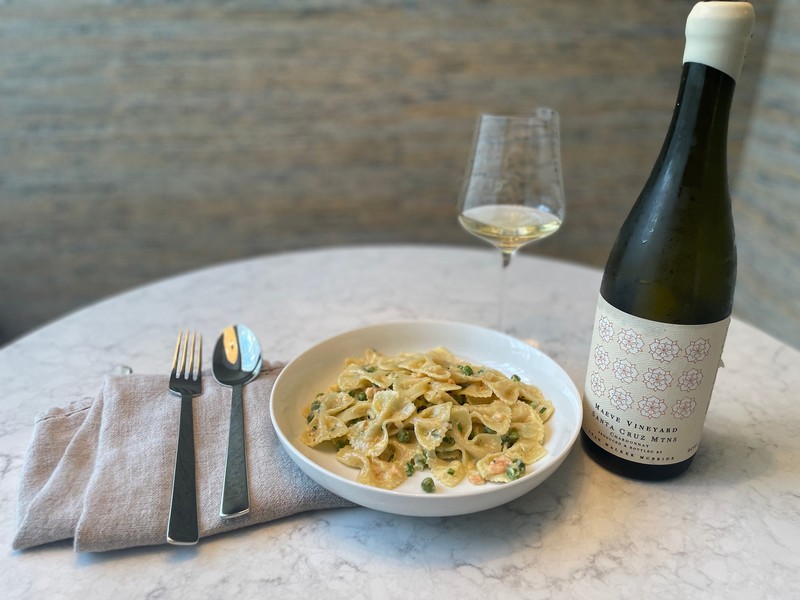
It's the perfect time of year for these fresh spring pasta recipes, doctored with ingredients fresh from the garden. This only-very-lightly-creamy pasta dish pairs so deliciously with our Maeve Vineyard Chardonnay from the Santa Cruz Mountains, and it was a perfect base recipe to add some fresh peas and wild dill from our garden. The inspiration came from an old recipe in Food & Wine Magazine (pictured) to which we added a couple ingredients and updated the proportions a little bit.
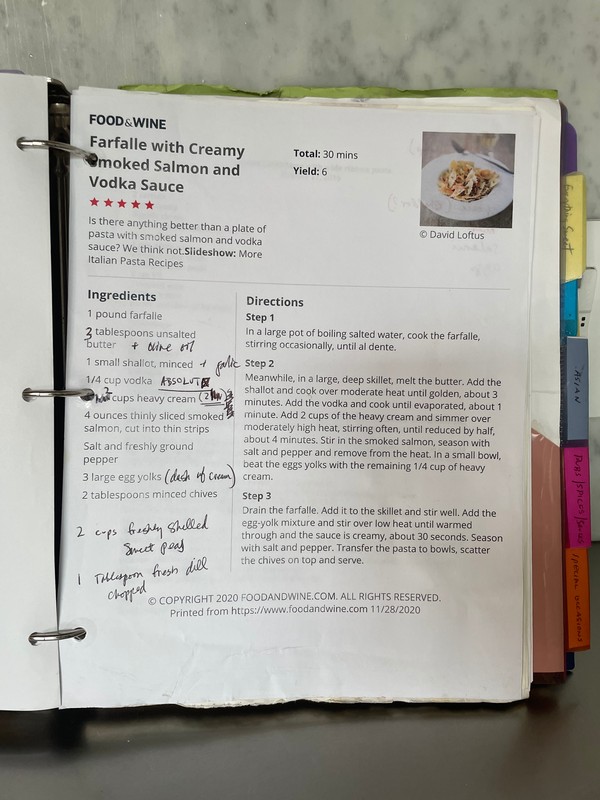
Ingredients:
- 1 pound farfalle
- 3 tablespoons butter, cut into 1 tablespoon chunks
- 2 tablespoons olive oil
- 1 small shallot, halved and sliced thinly
- 3 garlic cloves, chopped
- 1/4 cup ABSOLUT vodka
- 2 cups heavy cream (plus a dash for the eggs)*
- 4 ounces smoked salmon, cut into 1" strips
- 2 cups freshly shelled sweet peas
- 1 tablespoon fresh dill, chopped
- 3 large egg yolks (plus a dash of cream)
- 2 tablespoons fresh chives, chopped into tiny pieces
- Maldon sea salt and frehsly ground red/black/green peppers to taste
* We don't keep fresh cream in the house on an everyday basis, and we don't cook with it often enough to have any use for left over heavy cream, so this is admittedly a terribly annoying amount of cream to have to purchase for this dish and then not to use. So we just purchase a pint of heavy cream and then set aside a dash to add to the eggs in order to finish the sauce. And if you forget to add that dash to the eggs and instead add it all to the cream sauce, well like so what? Just add the eggs to the pasta sauce at the very end as if you're making a carbonara.
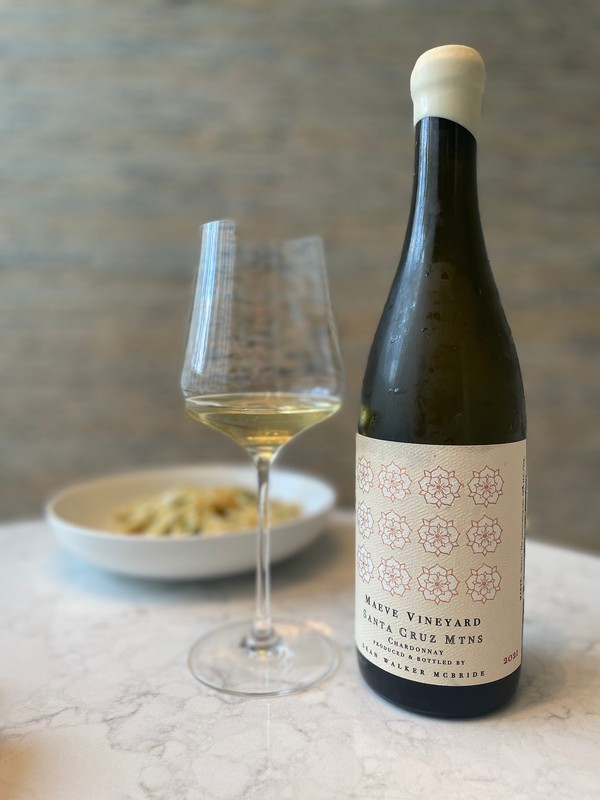
Preparation:
- Melt the butter in the olive oil, don't let it brown.
- Add the shallots, give it a minute, then add the garlic. Season with a little Kosher salt. Let them sweat. Time for a glass of Chardonnay!
- Remove the sauce pan from the heat, carefully add the ABSOLUT**, then return it to a simmer. A sniff of boiling vodka won't hurt anyone :) It's delish!
- When the vodka has reduced by half, add the cream, and stir to consolidate. A little spring of fresh dill in the cream isn't a bad idea, just don't get carried away. How's that chardonnay tasting?
- Give that cream a chance to come up to a gentle simmer, and start to skim the solids into the sauce. It's a good time to add the peas, to let them soften as the cream condenses. Then add the rest of the fresh dill. In about five minutes of a gentle simmer, add the smoked salmon strips, and give them a couple minutes in the sauce to tighten up. Keep stirring everything together, then remove from the heat and set it aside.
- Immediately drain the pasta, and return it to its pot. Cover it with your cream sauce. Stir in your egg yolks, and let it all rest together for about five minutes. Then plate in shallow bowls, and enjoy
Serve with our Maeve Vineyard Chardonnay Santa Cruz Mountains 2021.
** ABSOLUT is our "absolute" favorite cooking vodka. We use it for every dish that calls for vodka. It's punchy enough to add a bit of flavor, but not so expensive we feel we're pouring money down the drain. ABSOLUT is a Kitchen Staple in our house.
Cooking with Crosby Roamann: Sushi with fresh wasabi from our garden
(Pictured: blue fin tuna nigiri with daikon radish, scallions, and fresh wasabi)
Yes, okay, so it took two plus years to grow, but I finally managed to harvest my own wasabi plants from roots purchased in Oregon in 2021. When they arrived in the mail, the wasabi roots were about an inch long and had a handful of small wasabi leaves growing on them. I planted them in an 18" trench planter filled with compost and potting mix in a shady spot along our fence line and put a water line on them for three times per week. At first, everything started to grow brilliantly, but that was mid-Spring. As the angle of the sun changed over the beginning of the summer the wasabi came into direct sunlight during the middle of the day, and that's when we lost the first two plants to dehydration.
Another two plants died a couple weeks later during a heatwave due actually to over-watering. At that point, I took the water line of the remaining wasabi root, which was still doing pretty well, and transfered the planter to the north side of the house, where it wouldn't receive any direct sunlight at all. Without the water line on it, I had to warer it manually once per week over the rest of the summer and into the wall. So that's the story of how you turn five good wasabi plants into one. By the time winter rolled around, our one wasabi remained and was doing pretty well.
Fast forward to May 2023, and our little wasabi box has survived two brutal summers and some benevolent neglect in the watering schedule. Our main root has spawned a number of smaller root systems in the box, and at harvest, the first job was to dig these all out by hand and separate them. The smaller roots balls will be replanted with fresh potting mix in the same box.
Step 2: Dinner! We trimmed the wasabi root down to one long root about nine inches, then peeled off the coarse outer skin. To prepare fresh wasabi, we use this sharkskin hand grater that we purchased in Tokyo.
We ground some daikon radish ("oshinko") from the Japanese market in San Francisco (Nijiya, click here) ...
and we thinly slice fresh scallions ...
and halve eight fresh scallops, without cutting all the way through, leaving one edge attached ...
To prepare our sushi rice, we use a rice steamer purchased from Nijiya (this was one of the best buys we ever made -- it turns out consistently delicious rice without any hassle and is easy to clean). Once the rice has finised cooking, we pour about 1/3 cup of Rice Vinegar (we prefer the fancy stuff from Nijiya, but any rice vinegar will do) and 1 tablespoon of Aji Mirin into the rice pot, we stir it up gently, and let it sit for 15 minutes. We leave the rice cooker on "warm" -- which is how we like to prep our sushi.
We rub a small dash of the freshly ground wasabi on each scallop and each piece of thinly sliced tuna, then we prep a small ball of rice -- about 1 tablespoon of seasoned rice -- rolling it in our left hand into a thumb-sized lump. We top this lump of rice with fish, and press it firmly into place using two fingers pressing the fish down into the rice ball in our left hand. From then, all we have to do is adjust and garnish the pieces of sushi.
(Pictured: lightly seared fresh hotate "scallop" nigiri with fresh wasabi, nori wrap, with Maldon sea salt and oshinko garnish.)
Cooking with Crosby Roamann: Pâté de Campagne – aka Country Pate
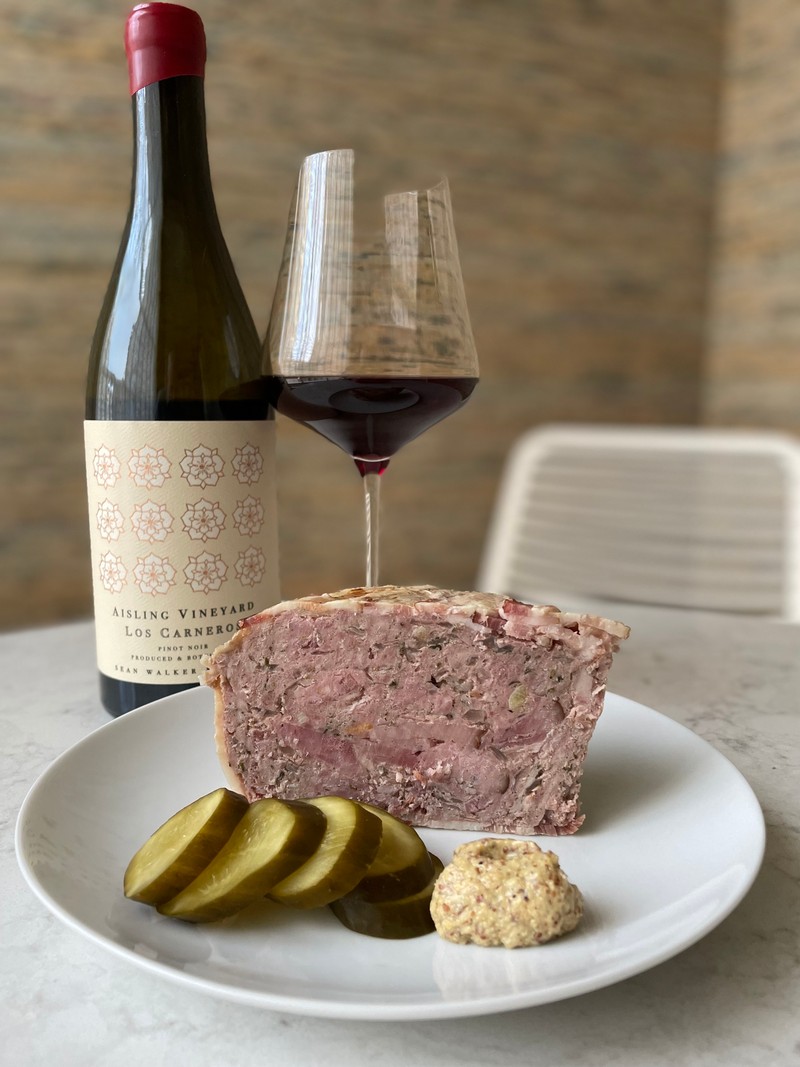
Cooking with Crosby Roamann: Pâté de Campagne – aka Country Pate
Ingredients
- ¾ cup Brandy (we use house made Crosby Roamann brandy – call us for info)
- 3 tablespoons unsalted butter
- 1 cup chopped onion
- 1 pound ground veal
- 1 pound ground pork
- 2 packages bacon (about 1.5 pounds) chopped into 1” pieces
- 5 garlic cloves, finely chopped
- 2 ½ teaspoons Kosher salt
- 2 ½ teaspoons dry thyme
- 2 teaspoons dry rosemary
- 1 teaspoon ground black pepper
- 2 large eggs, lightly beaten
- ½ cup heavy cream
- 1 small ham steak, cut into ¼-inch thin strips
Preparation
- Preheat the over to 350 degrees.
- Boil Brandy until reduced to 1/2 cup, about 2 minutes. Let it cool.
- Melt butter in a skillet over medium heat, then add onion, and later, the garlic, and saute until the onion is soft and translucent but not brown, about 10 minutes.
- While the onion and garlic are cooking, combine ground pork and bacon in large bowl using your fingers. When the onion has cooled a touch, add the onion salt, thyme, rosemary, and pepper to bowl with pork mixture and mix until incorporated. Add eggs, cream, and reduced Cognac. Mix well. You now have a big bowl of pate filling!
- Line a 9x5x3-inch metal loaf pan with bacon slices, arranging bacon slices across width of pan and a couple slices on each short side of pan and overlapping pan on all sides. Using hands, fill the terrine halfway with the meat filling, then arrange ham slices throughout the middle of the pan in a middle layer, then top with remaining meat mixture. I like to heap the meat filling into a mound on top of the pan, then cover it with the bacon slices that are hanging over the sides of the pan.
- Cover the pan tightly with foil and place it in a larger (13x9x2-inch) metal baking pan and transfer them to the oven. Pour boiling water into baking pan to come halfway up sides of loaf pan. Bake pâté about 2 hours 15 minutes.
- At the conclusion of baking, remove the pate pan from the baking pan and then dispose of the water from the baking pan. Return the pate pan to the baking pan, and place a heavy skillet filled with 2 to 3 heavy cans atop pâté to weigh down. Let this rest for an hour or so, until it has cooled. Then chill overnight.
- Place loaf pan with pâté in larger pan of hot water for about 3 minutes. Invert pâté onto platter; discard fat from platter and wipe clean. Cut pâté crosswise into 1/2-inch slices.
- Serve with good bread, cornichons and country Dijon mustard. Enjoy!
(Adapted from Bon Appetit Magazine)
Cooking with Crosby Roamann: Osso Buco
Cooking with Crosby Roamann: Osso Buco
Osso Buco (translated "bone with a hole") has been one of my favorite dishes since we first tasted this sumptuous dish at the Mario Batali West Village staple Babbo in the early 2000s. It's perfect in the early spring when it's still a little too cold for warmer pasta sauces and I'm in the mood for something hearty -- plus, the veal is in season. Personally, we like to dress this down and serve this dish with butter noodles or simply a good, crusty bread. You will want a small spoon to dig the bone marrow out, and I suggest eating it with a slice of crispy bread first, then digging into the main course. Enjoy!
Ingredients
- 6 tablespoons olive oil
- 2 tablespoons unsalted butter
- 4 portions veal shank
- ½ cup flour
- 1 cup each chopped onions, carrots, celery
- 3 cloves garlic
- 1 ½ cups dry white wine (we use leftover Crosby Roamann Chardonnay)
- 1 can chopped tomatoes, or whole peeled tomatoes chopped with their juice
- 2 cups veal, beef or chicken stock
- 1 teaspoon dry thyme
- Freshly ground black pepper to taste
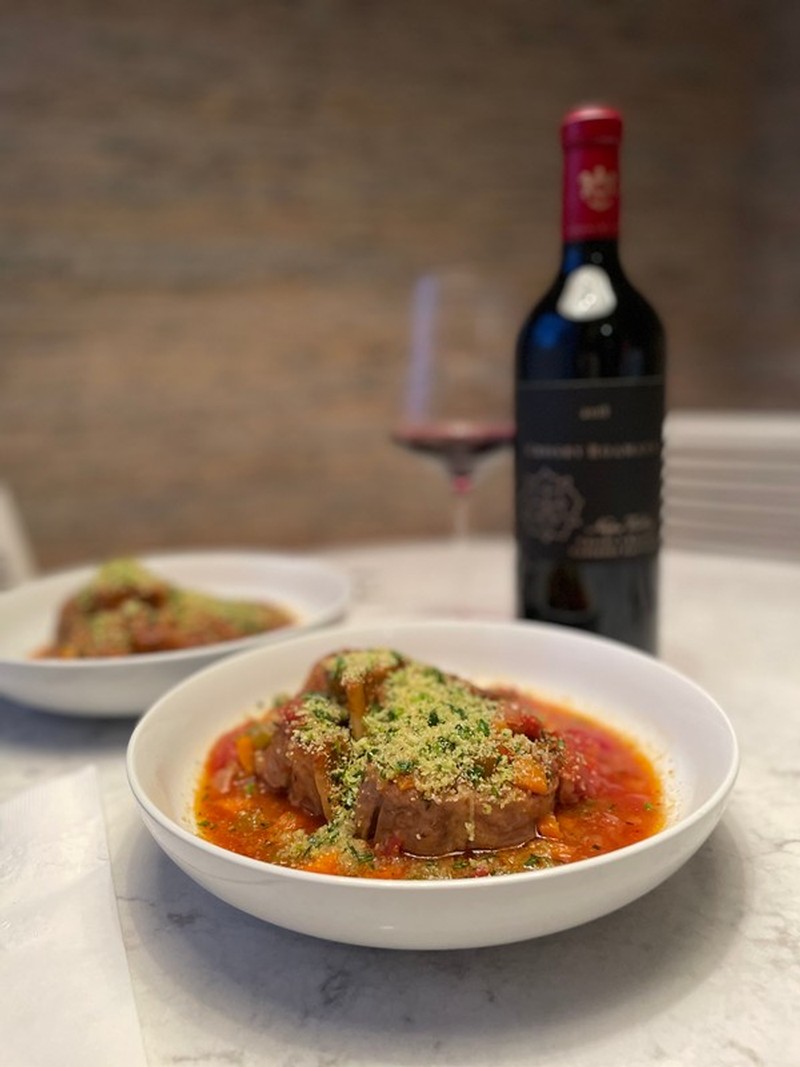
Preparation
- Preheat the oven to 350 degrees.
- Melt the butter in a large casserole (big enough to hold all the veal shanks side by side) with the olive oil over medium heat.
- Dredge the veal shanks in lightly salted flour then shake off the excess and sear them on all sides in the hot oil and butter, then set them aside, and reduce the heat.
- Add a little more olive oil if the casserole is dry, then add the onions, carrots, and celery and, after a couple minutes, the garlic too, and lightly brown everything, stirring it all together.
- Add the wine, and reduce by a quarter. When the smell of alcohol has evaporated, add the tomatoes and juice and seasoning thyme and bring it back to a light boil. When it begins to boil again, add the stock, and return it to a light boil.
- Add the veal shanks, and baste with the sauce – about five minutes. At this point, cover the casserole and transition it to the preheated over to bake for about 1.5 hours. Baste several times during this time.
- When you are ready to serve, plate each veal shank in a shallow bowl, and add enough sauce to cover the veal shank about halfway. Sprinkle the veal and sauce with Gremolata topping (recipe below), and serve warm.
Gremolata (topping/garnish) a mixture of:
- 1 large garlic clove, very finely minced
- Grated rind of one lemon
- ¼ cup finely chopped parsley
- ¼ cup fine breadcrumbs
Adapted from Florence Fabricant – NY Times Cooking
Cooking with Crosby Roamann: King Crab California Rolls

Many years ago when I had just graduated from college, and was still trying to figure out what the hell I wanted to do with my life, and I was spending far too much time in New York City drinking and eating with friends (but then what else is a 20-something to do in the city?) there was a little French bistro near where we used to live in Manhattan called Bandol Bistro. (You can even still find a decades-old write up of the restaurant online here.) Bandol offered a Steak Frites brunch special for $18, which friends and I would order with a bottle of Bandol rosé.
Why do I mention this absurd story? Because I wanted to mention that there is no more perfect food pairing than Steak Frites and a bottle of rosé on a Sunday morning if you are with people you cherish.
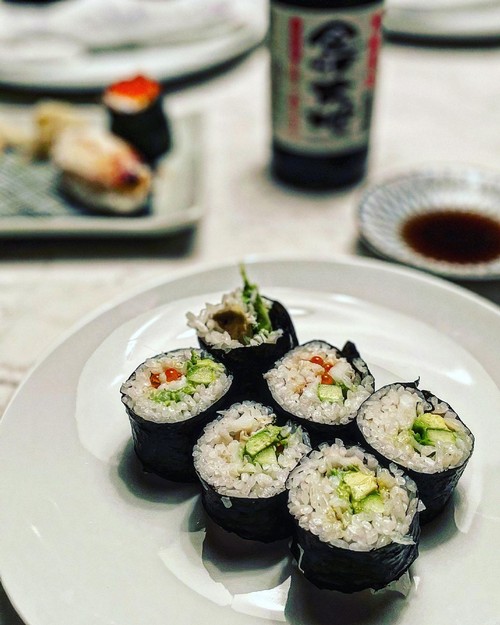
So we've decided to go the other direction for this month's #CookingWithCrosbyRoamann and do something almost as bizarre -- pair Cabernet Sauvignon with King Crab. King Crab is in season currently in North America, and it's a perfect time on a chilly winter night to steam up a small portion of crab with some short-grained rice, avocados, and cucumber for your own homemade California Roll. Recipes below. Pair it with a bottle of Crosby's Reserve Cabernet Sauvignon and enjoy it with loved ones.
Bon appetit!
Ingredients -- Most of our ingredients are purchsased from Nijiya Market on Webster Street in Little Japan, but you can find them at most Whole Foods and speciality grocers around the states.
- 1.5 cups Sushi rice (we use this short-grain rice)
- 3 Tbspn Sushi vinegar (we use this vinegar)
- 1 Tabspn Aji-Mirin (like this one from Target, also check out this article on Mirin from Bon Appetit Magazine)
- Sake (for the sushi rice, any low-quality style will do)
- Nori -- use the best you can find, we prefer toasted "gold" grade like this one
- Wasabi -- again, use fresh Wasabi from the northwest if you can find it, if not, any premade style will do, as will wasabi "powder"
- about 3/4 lb. King Crab, frozen (or about 1 half crab)
- 1 avocado
- 1 Japanese cucumber
- Salmon roe (optional)
Special Equipment
- A rice steamer (we use this one from Zojirushi)
- A bamboo sushi mat (like this one from Amazon)
- A crab/lobster cracker (or at least a pair of strong kitchen scissors)
Preparation
- Add the rice with 2 cups of water to the rice cooker with one tablespoon of Sake, and let it sit for 30 minutes. Then cook the rice according to the machine's instructions -- our cooker takes about 20 minutes of steam time, followed by 10 minutes of absorption.
- Open the rice cooker and turn it off. Sprinkle sushi vinegar and Mirin, then stir with a flat wooden or plastic spoon (like the one which comes with the rice cooker). Let the rice sit for a couple of minutes until it is cool enough to handle, but not cold. Good sushi rice should be warm.
- Meanwhile cut your Nori wraps to 3/4 quarter length -- any shorter, and it may not close all the way; any longer, and it will leave an unsightly tail.
- When the rice is ready, using slightly wet hands, grab about a big handful of rice and spread a thin layer of sushi rice over about 3/4 of the Nori wrap -- I leave a thin strip at the bottom of the wrap, and about a 1 inch strip at the top of the wrap, as pictured.
- Spread 1/2 teaspoon of Wasabi (or more, to taste) in a straight line from left to right along the sushi rice.
- Spread 1/4 cup of fresh King Crab meat directly along the wasabi, top with a few thin slices of cucumber and avocado, and top with salmon rose if available.
- Using your thumbs to gently lift the bottom of the suchi wrap and your fingers to hold the meat and avocado in place, pull the bottom of the suchi wrap up and over the meat and vegeatble section of the wrap, then gently roll it forward till it closes. Squeeze the wrap gently.
- Cover the wrap with your bamboo sushi mat and PRESS the roll tightly, but not so tightly that crab pushes out the end of the roll! I like to Press, then roll the wrap a quarter turn, and then press again.
- Cut the roll using a moist and very sharp knife into six pieces, and plate accordingly. Top with extra salmon roe (optional)
- Serve with soy sauce and ginger and extra wasabi.
Enjoy!
Cooking with Crosby Roamann: Pork Schnitzel with German Potato Salad
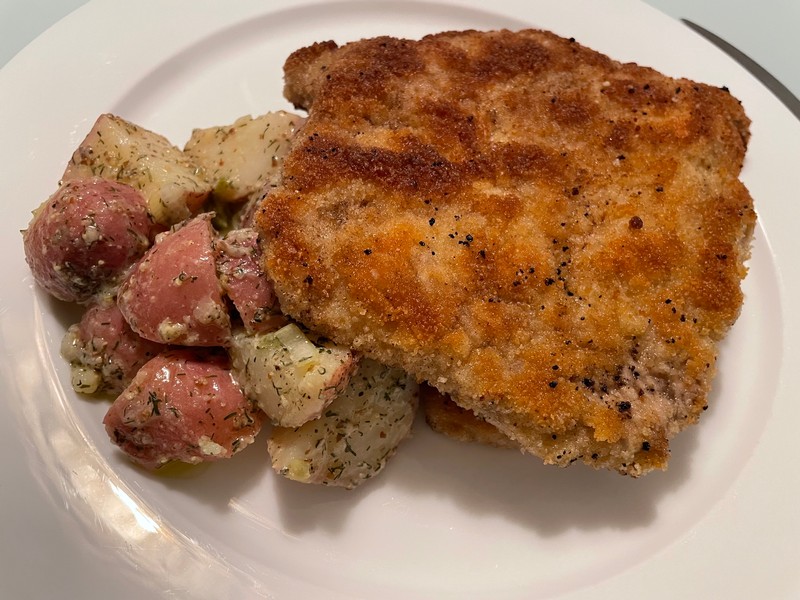
Every year on Grandpa Bob's birthday we make something like this pork schnitzel. The recipe has changed over the years -- sometimes we make it with veal, the real Wiener Schnitzel style -- but often we make it with pork instead. Grandpa Bob loved it both ways. There are so many versions of schnitzel recipes out there, but the basic premise is always the same. A good example, and the version we checked out this year as a refresher, was this classic recipe from Martha Stewart: Wiener Schnitzel with Pork.
 One thing that doesn't seem to change is the accompanying German Potato Salad. I have been developing this recipe for decades now, and we use it to accompany most of the schitnzels we make at home, as well as a lot of our summer BBQ. It's easy, delicious, and quick.
One thing that doesn't seem to change is the accompanying German Potato Salad. I have been developing this recipe for decades now, and we use it to accompany most of the schitnzels we make at home, as well as a lot of our summer BBQ. It's easy, delicious, and quick.
This dish pairs perfectly with both our Chardonnay and Pinot Noir. Check them out here.
Enjoy!
German Potato Salad
Ingredients
- 1.5-2 lbs. small red potatoes, quartered
- 3 scallions, whites and green parts, halved and sliced thinly
- 3 Tbspn European style butter
- 1 Tbspn olive oil
- 1 Tbspn white wine vinegar (we make our own with leftover white wine, and have it available for free at the tasting room)
- 4 Tbspn Grey Poupon Country Dijon Mustard
- 1 Tbspn dry dill (during the summer we sub this for fresh)
- 1 Tbspn Kosher salt
- Fresh cracked black pepper to taste
Directions
- Place the quartered potatoes in a small saucepan (like this one from Williams Sonoma) and cover halfway with cold water. Cover and bring to a boil, then uncover and simmer gently until the water has mostly evaporated, leaving only a tablespoon or two. Remove from the heat.
- Add butter immediately, then the olive oil, vinegar, mustard, dill, salt, and a crack of pepper. Add scallions. Stir to coat (try not to mush the potatoes too much!)
Enjoy!

